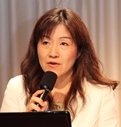��Centennial of Xinhai Revolution�� Pledge
between Sun Yat-sen and Shokichi Umeya��
April 13, 2011
Ms. Ayano Kosaka
Managing Director, Hibiya Matsumotoro
 ��Mr. Sun Yat-sen is a highly respected figure for the Chinese, as much as Mr. Mao Tse-tung. Not much is known in China, however, about Mr. Sun��s connection with the Japanese. Likewise, not many Japanese know about the Xinhai Revolution.
��Mr. Sun Yat-sen is a highly respected figure for the Chinese, as much as Mr. Mao Tse-tung. Not much is known in China, however, about Mr. Sun��s connection with the Japanese. Likewise, not many Japanese know about the Xinhai Revolution.
��Mr. Sun actually spent nearly 10 years in Japan, out of his 30-year-life as a revolutionist. He built close friendships with only a few Japanese, including my great-grandfather Shokichi Umeya.
��When President Hu Jintao visited Japan in 2008, he first came to Matsumotoro in Hibiya Park with former Prime Minister Fukuda to see the historical documents showing the friendship built between Mr. Sun and Shokichi Umeya about 100 years ago.
��Shokichi was born in 1868. His family was trading merchants in Nagasaki. He was an adventurous boy, full of charitable spirit. At the age of 14, he travelled to Shanghai on his family ship, the place of his long-cherished dream. To his disappointment, however, he witnessed the plight of Chinese people deprived of their human dignity in colonized Shanghai by the Western powers. Shokichi felt the need to ��change the situation, and make Asia stronger by the Asian people.��
��Mr. Sun also set out for Hawaii and left his hometown in Guangdong Province at the age of 13. Mr. Sun and Shokichi both travelled abroad, as young teenagers, and had the chance to observe their own countries from outside. Such common experience made them both feel strongly attached to China.
��Shokichi became successful in Hong Kong as a photo studio owner. He was introduced to Mr. Sun by a British man named James Country, who felt these two men could make action to improve the plight of China humiliated by Western countries. Mr. Sun was 29 years old, and Shokichi was 27.
��The more the two discussed, the more surprised they became to find that they shared so many points of view. Commenting on their meetings, Shokichi said ��I was greatly impressed by how brave and enthusiastic Mr. Sun was. His insight on deepening goodwill between China and Japan, promoting interactions among Eastern countries and respecting human equality, by means of revolution in China, coincided with my own belief. I pledged my eternal friendship.�� Shokichi promised to ��give financial assistance to Mr. Sun, should he take up arms.�� As history proves, he stayed faithful to his words throughout his life.
��Financially backed by Shokichi, Mr. Sun rose up in revolt in Guangzhou, his first uprising which later developed into the Xinhai Revolution. Shokichi took refuge in Singapore, as the Qing government issued an arrest warrant on a charge of assisting Mr. Sun. Shokichi started the movie business in Singapore. He founded the movie company named ��M Patay Firm�� upon his return to Japan, which quickly became the top company in the movie industry. The very first documentary film on the Antarctic expedition made by Captain Shirase was a big hit. Shokichi later merged three other movie companies and established the Japan Cinematograph Company, popularly called ��Nikkatsu��. There is another precious film Shokichi produced which documents the Xinhai Revolution. Although history textbooks credit Mr. Sun with initiating the Revolution, Mr. Sun was actually not in China and was staying in the US, Japan and Europe. Shokichi sent the film crew to Wuhan, Hubei Province, with the sole desire of showing Mr. Sun the actual scenes of the Revolution. Today, the original film is stored at CCTV in Beijing
��Shokichi sent arms and ammunition to the Revolutionary troops. He even made a flight training school in Shiga Prefecture, as Mr. Sun requested airplanes to be used for the third revolution that attempted to topple Yuan Shikai.
��Let me touch upon the romantic side of Mr. Sun. In China, the three Soong sisters are famous: Soong Ai-ling, the eldest, loved fortune and got married to the richest businessman in China, Hsiang-Hsi Kung; Soong Ching-ling, the younger, loved the nation and got married to Mr. Sun; May-ling Soong, the youngest, loved power and got married to the former President Chiang Kai-shek .
��Soong Ching-ling was educated in the US, and met Mr. Sun in 1915 here in Japan as she sought refuge with her father. She was 22 years old, and became an English secretary for Mr. Sun who was 48 years old. They fell in love, but unfortunately, Mr. Sun was married with three children and everyone around them strongly opposed their relationship. Her father brought her back to Shanghai. Mr. Sun got a divorce, enabling them to legally marry. Their wedding reception was held at Shokichi��s residence. Shokichi was a true supporter of Mr. Sun, both in his public and private life.
��Mr. Sun passed away on 12 March, 1925. Three months before his death, Mr. Sun sent a telegram to Shokichi stating ��I am grateful for all your hospitality. I sincerely wish for your cooperation in reconstructing Asia as a whole, and for your good health.��
����Helping each other makes the world go round.�� ��Wealth and honor do lie in one��s heart.�� Shokichi Umeya did believe in such principles, and he devoted his life for others. After the War, Ms. Soong Ching-ling became the Vice Chair of the People��s Republic of China. She wanted to meet the daughter of Shokichi Umeya, my grandmother, who had the honor to be invited to Beijing. There are various historical aspects between Japan and China, but I do wish to keep conveying the history of mutual help to the coming generations.